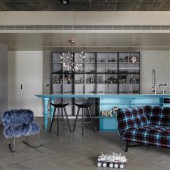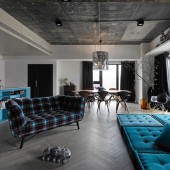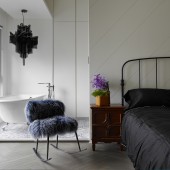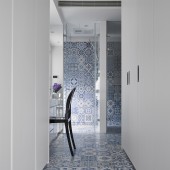
| THE AWARD |
| CATEGORIES |
| REGISTRATION |
| SUBMIT YOUR WORK |
| ENTRY INSTRUCTIONS |
| TERMS & CONDITIONS |
| PUBLICATIONS |
| DATES & FEES |
| METHODOLOGY |
| CONTACT |
| WINNERS |
| PRESS ROOM |
| GET INVOLVED |
| DESIGN PRIZE |
| DESIGN STORE |
| THE AWARD | JURY | CATEGORIES | REGISTRATION | PRESS | WINNERS | PUBLICATIONS | ENTRY INSTRUCTIONS |
At Will Residential House by Ganna Design |
Home > Winners > Design #40075 >Interview |
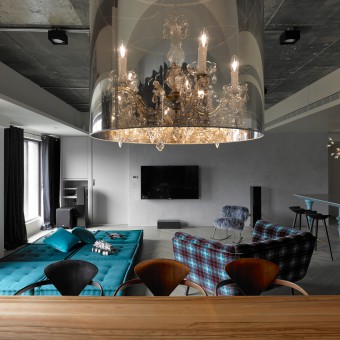 |
|
FS: What is the main principle, idea and inspiration behind your design?
TC: The owner owner would like to have a different bathroom from the general bathroom in Taiwan. Since the house equipped the sufficient natural illumination, we try to make the best use of it. Then we started to change the layout, making user in the bathroom can enjoy the window view. Also, traffic flow is another point while designing this project.
FS: What has been your main focus in designing this work? Especially what did you want to achieve?
TC: The traffic flow and the natural illumination are the main focus in designing this work. We want to preserve all the favorable environmental conditions and make the best use of them. Except for the above mentioned illumination condition, we focus on the interaction of people in the house. Hence, traffic flow is the first point that we can optimize the relationship among people.
FS: What are your future plans for this award winning design?
TC: There is no future plans for this award winning design. We were commissioned to design this house and the project was closing.
FS: How long did it take you to design this particular concept?
TC: The building was under construction while designing this project, so we need to take the time of construction into consideration. It took us around half a year to design the whole concept of this project.
FS: Why did you design this particular concept? Was this design commissioned or did you decide to pursuit an inspiration?
TC: Yes, we were commissioned.
FS: Is your design being produced or used by another company, or do you plan to sell or lease the production rights or do you intent to produce your work yourself?
TC: No, we we're commissioned by the house owner. The house is the residential house.
FS: What made you design this particular type of work?
TC: The original condition of the house gave us room to realize our ideas freely. We started from the original cement ceiling, then gathered ideas about spatial layout from the sofa in the common area.
FS: Where there any other designs and/or designers that helped the influence the design of your work?
TC: We are appreciate the talent of a Spanish designer Jaime Hayon. Hence, one table leg of the kitchen island was influenced by his design.
FS: Who is the target customer for his design?
TC: A family.
FS: What sets this design apart from other similar or resembling concepts?
TC: The starting point set this design apart from other project. Instead of the space itself, we started from the sofa and the furniture. We hope to
FS: How did you come up with the name for this design? What does it mean?
TC: The main concept of this project is the living attitude: live at will, change at will. The sofa realizes the concept of Lego, making users in the house to piece them together at will. We hope that the furniture in the house can be changed or moved freely according to the emotion of the house owner.
FS: Which design tools did you use when you were working on this project?
TC: Some common software such as AutoCAD.
FS: What is the most unique aspect of your design?
TC: We think the common area is the most unique one. Since it is a place that combined the beauty of rough and the delicate. We preserve the original cement ceiling but we make use of the delicate sofa, large chandelier and designed bookcase to decorate the space. Hence, you can feel the sense of rugged while enjoying the artificial design at the same time.
FS: Who did you collaborate with for this design? Did you work with people with technical / specialized skills?
TC: I collaborate with Shih-Jie, Lin, the founder of Ganna Design, for this design. Both of us are designers.
FS: What is the role of technology in this particular design?
TC: No specific technology used in this design.
FS: Is your design influenced by data or analytical research in any way? What kind of research did you conduct for making this design?
TC: Except for the design of Jaime Hayon, this project has not been influenced by any other analytic research or data.
FS: What are some of the challenges you faced during the design/realization of your concept?
TC: No, we don't think so.
FS: How did you decide to submit your design to an international design competition?
TC: We think this project has a different concept. There's no specific style, no fixed relationship among different spaces or rooms. Besides, the soft decoration in the house can be moved flexibly. The above mentioned condition made us decide to submit this project to this international design competition.
FS: What did you learn or how did you improve yourself during the designing of this work?
TC: We think that this project may open a new road for us: jump outside the box and start the design from different element. We try to improve ourselves by thinks in different ways. We hope that we can make the best use of every materials and reduce the unnecessary adoption for decoration only.
FS: Any other things you would like to cover that have not been covered in these questions?
TC: No.
FS: Thank you for providing us with this opportunity to interview you.
A' Design Award and Competitions grants rights to press members and bloggers to use parts of this interview. This interview is provided as it is; DesignPRWire and A' Design Award and Competitions cannot be held responsible for the answers given by participating designers.
| SOCIAL |
| + Add to Likes / Favorites | Send to My Email | Comment | View Press-Release |

